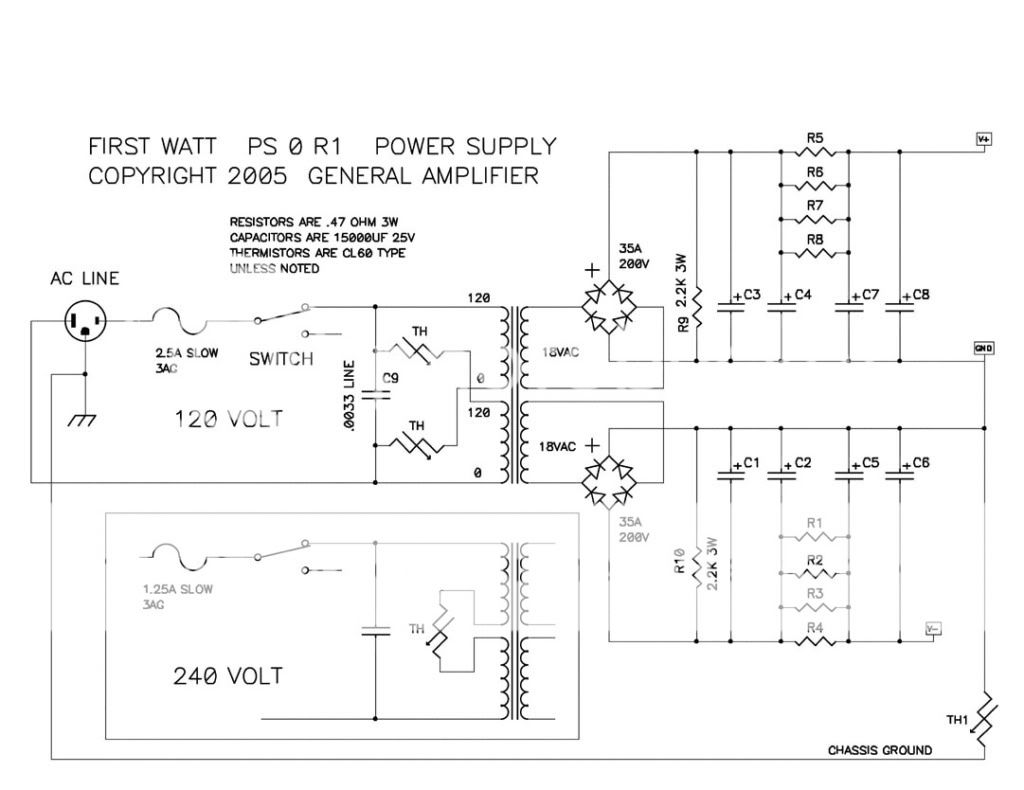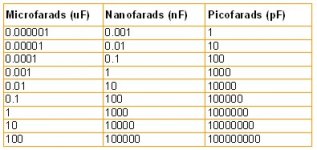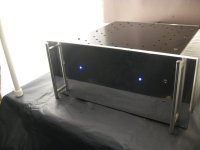I decided to build the headphone amp from the service manual, since the parts are minimal. It works just dandy, however the 50 watts of resistors making my 16ohm source resistor still run about 120c. The heatsink for the mosfet runs cool. Any idea what the ideal resistor wattage is here? Looks like a heatsink type for sure...
I think this amp requires preamp or buffer? what do you think about it? maybe B1 buffer will be good with this amp
I think this amp requires preamp or buffer? what do you think about it? maybe B1 buffer will be good with this amp
I think the other version has some gain. I was using it with computer - > output so can control gain with it there. I have giben up on it for several reasons
1.Didn't want to buy bigger resistors
2.Hummed, and could not figure out why, even with inputs shorted.
3.I built a 'mini-F4' that works dandy. Case and all almost done. It doesn't put out too much idle heat either.
I was wrong and Tinitus right about the cap value across the feedback resistors .
2200pf value given by Nelson in post 861.
Sorry. (Not to forget this is low impedance feed back)
2200pf value given by Nelson in post 861.
Sorry. (Not to forget this is low impedance feed back)
Last edited:
The closest I've got is to get a 1 dB peak at about 800 KHz.
Personally I wouldn't bother with anything at that value, but yours
appears to be a little more severe.
Looks to me like you'll have to break down and install 2 compensation
caps. one across each of the 50 ohm resistors on the feedback loop.
(By the 50 ohm I mean the parallel 100 ohm resistors.)
Suggested initial value would be .0022 uF.

I think it was a different problem
Is that what you are saying
Link http://www.diyaudio.com/forums/pass-labs/121228-f5-power-amplifier-85.html
Seems Nelson actually does suggest a 2.2nf on feedback loop
Well, I may have suggested 22-100pf, like others have, but a shot in the dark
We are talking about cap on R10(input), because oscillating is caused by connected source
Different value maybe ?
I hope we are not talking about removing amp oscillation, but are concerned about removing the problem from source causing the oscillation
Same thing or different ?
Attachments
Last edited:
Hi Fishski13!
What are those "soldering pins"? Where did you buy it?
Greets:
Tyimo
they're called "turrets" and favored by guitar tube amp builders. they need to be "staked" from underneath by either a staking tool, or a center punch. i bought them and the red G-10 glass epoxy board here: Boards and Board Making Parts. i'm sure they would be fairly easy to source in the EU.
Yes,my problem was the amp got burning hot when the dac was connected.
Wasnt it transformer coupled ?
Could it be high inductive loading causing it ?
Or maybe your interconnects, both inside and outside ?
Last edited:
Yes the DAC (CS4398) is transformer coupled,what to do about the inductance?
I have used the interconnects with my Benchmark DAC 1 whithout any problem(Heat).
I have used the interconnects with my Benchmark DAC 1 whithout any problem(Heat).
Last edited:
Thanks Fishski13!they're called "turrets" and favored by guitar tube amp builders. they need to be "staked" from underneath by either a staking tool, or a center punch. i bought them and the red G-10 glass epoxy board here: Boards and Board Making Parts. i'm sure they would be fairly easy to source in the EU.
Yes the DAC (CS4398) is transformer coupled,what to do about the inductance?
I have used the interconnects with my Benchmark DAC 1 whithout any problem(Heat).
Hi Ryssen,
Do you know what the output impedance of the DAC is? If it is very high then the addition of capacitance may be creating a low pass filter. As suggested by juma I've been reading Borbely's jFet paper (http://www.borbelyaudio.com/adobe/ae599bor.pdf). It describes a type of distortion that may be relevant to you if you have a high source impedance coming in.
from Borbely
"As though the existence and size
of the input capacitance were not
enough, it is also voltage dependent,
which might cause distortion
in certain applications. Figures 10A
and 10B show the voltage dependence
of Ciss and Crss, respectively,
of the K170 JFET.
Depending on the excursion of
the input/output signal, you get a
capacitance modulation, and this
can cause distortion of the audio
signal. This shows up mostly when
you drive the circuit from a highsource
impedance."
Perhaps you can try lowering the jFet capacitance by either cascoding or increasing the source resistors (R1&R2)
This is the trafo LL1517 http://www.canford.co.uk/ProductResources/ig/2735.pdf
It says,Secondarys in series(which i have) 600 ohm,that don seem so high.If it has anything to do with it it has 1k and 2,2nf in paralell,at secondary.
It says,Secondarys in series(which i have) 600 ohm,that don seem so high.If it has anything to do with it it has 1k and 2,2nf in paralell,at secondary.
Hi there
I am currently at page 176, only another 438 and counting!
I have built various chipamps over the last couple of years and now fancy having a go at Nelson's 'F'-series. I have heard that several versions can use the same unregulated power supply. Can I build one power supply to work with entire range? If not, which models are compatible with the supply below?

I am also trying to source an enclosure with a suitable heatsink.
modushop.biz
Would someone be kind enough to check the attached PDF and let me know which model would be suitable?
I will also be driving a pair of Brines FT-1600 Mk2 Speakers
Thanks for your help 🙂
I am currently at page 176, only another 438 and counting!

I have built various chipamps over the last couple of years and now fancy having a go at Nelson's 'F'-series. I have heard that several versions can use the same unregulated power supply. Can I build one power supply to work with entire range? If not, which models are compatible with the supply below?

I am also trying to source an enclosure with a suitable heatsink.
modushop.biz
Would someone be kind enough to check the attached PDF and let me know which model would be suitable?
I will also be driving a pair of Brines FT-1600 Mk2 Speakers
Thanks for your help 🙂
Attachments
Last edited:
5U seems missing in your attached file
You may be fine with the 160mm 4U, but I would choose the 200mm 5U-300mm
300mm has to my knowledge ONE whole heatsink on each side, the 400mm is split into double heatsinks, and not optimal, unless you build your own boards to suit, or hardwire
btw, someone mentioned that new models are coming, completly aluminium instead the soft steel used now
You may be fine with the 160mm 4U, but I would choose the 200mm 5U-300mm
300mm has to my knowledge ONE whole heatsink on each side, the 400mm is split into double heatsinks, and not optimal, unless you build your own boards to suit, or hardwire
btw, someone mentioned that new models are coming, completly aluminium instead the soft steel used now
Last edited:
As tinitus stated, the bigger, one-piece, heat sink is a better choice. There is a lot of heat being dissipated.
I built the F5 using these sinks: M&M metals 62430.
The case is an all aluminum DIY affair and I've noticed that the case, itself, is acting as a complimetary heat sink. I am able to hold my hand or forearm on the top of the heat sinks, indefinitely. For reference, the faceplate (pic attached) is 19" x 8".
I built the F5 using these sinks: M&M metals 62430.
The case is an all aluminum DIY affair and I've noticed that the case, itself, is acting as a complimetary heat sink. I am able to hold my hand or forearm on the top of the heat sinks, indefinitely. For reference, the faceplate (pic attached) is 19" x 8".
Attachments
Last edited:
5U seems missing in your attached file
You may be fine with the 160mm 4U, but I would choose the 200mm 5U-300mm
300mm has to my knowledge ONE whole heatsink on each side, the 400mm is split into double heatsinks, and not optimal, unless you build your own boards to suit, or hardwire
btw, someone mentioned that new models are coming, completly aluminium instead the soft steel used now
Thanks for the info 🙂
It will be nice to have a thicker aluminium base plate to tap a thread. At around £200 the cases are not all that cheap, oh well...
- Home
- Amplifiers
- Pass Labs
- F5 power amplifier

